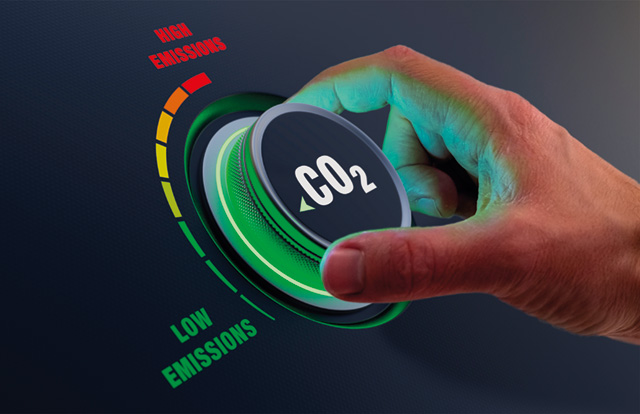
Carbon reporting requirements are set to increase for businesses in the wake of COP 26. The M&E Editorial Advisory Board discussed the impact of the landmark climate conference and next steps for industry.
Accelerated action to tackle climate change has been promised by countries across the world under the Glasgow Climate Pact agreed at COP 26 in November.
Signatories including the UK which hosted the conference pledged to revisit and strengthen their current 2030 emissions targets this year, in a bid to keep alive the Paris Agreement’s ambition to limit global warming to 1.5°C or lower.
COP 26 also saw a Paris Rulebook finalised, which includes a transparency process to hold countries to account in the delivery of their stated targets, and the conference also agreed action on phasing down fossil fuel usage.
However, with the UK Government targeting net zero by 2050, significant uncertainty is still hanging over what this means for manufacturing, maintenance and asset management, members of M&E’s Editorial Advisory Board agreed in a roundtable discussion on the implications of COP 26 in December.
Participants highlighted a need for clear guidance and rules to steer industry’s path to net zero and concluded that the establishment of a carbon regulator will likely be required to ensure companies properly record their emissions, and to monitor progress on reduction.
DAK Consulting director Dennis McCarthy said: “One of the key things that came out of COP 26 was the fact the government is going to require large companies – and later all companies – to report on climate risks and set out their glide path to net zero.”
The conference also saw the launch of an International Sustainability Standards Board which will formulate global reporting standards for businesses, with a focus on carbon emissions. But according to Mr McCarthy there is currently a lack of clarity around rules for reporting on carbon.
“Somewhere along the line there will be a need for a template to help organisations conform to the rules, and do it in a way that is not just greenwashing,” he said.

‘I wonder how we could define the role that good maintenance practice can have in tackling emissions.’
Dennis McCarthy
DAK Consulting
Asset management specialist Dr Peter Geake highlighted a need to foster greater “practice maturity” in the sector around managing carbon emissions. “We have got the high level aspirations, but in terms of distilling those down into something actionable that gives people the ability to make logical decisions on a daily basis, I don’t think we have got that structure as of yet.”
As an example he highlighted the East West Rail transport infrastructure project to connect Oxford and Cambridge, for which he heads up a whole life costing function. “We are incorporating carbon accounting and biodiversity into that and building a decision support tool to help designers assess their options to meet those requirements,” he explained.
While the government has set a target to cut by half carbon emissions embedded in building materials used on the project, “how we deliver that is up to us to define in a very loose way”, he pointed out.
Founder and principal consultant of Systems Excellence Graham Cooper suggested that the sector’s primary challenges when it comes to getting a handle on emissions will be in decarbonising raw materials and ensuring honest and accurate carbon reporting along the supply chain.
“You have got to look at the energy you consume,” he said, but noted: “The way things are going, the grid is expected to go green in this country – the ultimate end consumer will be consuming either hydrogen or green electricity, I think.
“The devil therefore is in the raw materials – concrete and steel – what is going to happen to those and how are they going to be accounted for?” He pointed out that such materials will fall under businesses’ indirect ‘Scope 3’ emissions, meaning firms will increasingly need to rely on the carbon data of companies further upstream in the supply chain being accurate.

‘I’m concerned that companies could declare net zero based on offsetting, but the data might be quite flimsy.’
Graham Cooper
Systems Excellence
“I don’t know who is going to audit that,” he said. “Who makes sure these declared carbon foot-prints are actually real?” He said the issue of accurate reporting is particularly concerning in cases where firms upstream are offsetting their emissions.
“My big concern is that you could have a company declaring net carbon zero based on offsetting, and the data could be actually quite flimsy. There is going to have to be a tight legislative frame-work around this.”

‘Understanding your maintenance activities to control the carbon in that process is very important.’
Dr Peter Geake
Asset management specialist
Dr Geake said: “Once businesses have identified how much they can save through choice of materials, products and things of that nature in terms of carbon, both embedded and operational, then what do we have left? Offsetting is one way to go.”

But he agreed there will always be uncertainty as to how effective carbon offsetting will be and said: “The due diligence you need to do on an offsetting scheme is significant. Are they really going to create a reduction in carbon in the environment?”
Participants agreed on the need for a carbon regulator to which companies could be obliged to demonstrate the accuracy and honesty of their carbon accounting.
“Establishing carbon accounting rules that can be audited, with a third party to police it – that is a core way to activate all this,” said Dr Geake. “If we want to hit our emissions goals we have got to have measurement, monitoring and corrective action generated by some central organisation, and there is no evidence of that at the moment at all. I see that as the key conclusion.”
Dennis McCarthy called for a standard to be developed for carbon measurement and reporting at ISO level. “I think what is really needed here is a standard; for example ISO 50001 has got some great principles for energy management which if adopted will help companies save money and save the planet,” he said. “We need guidance that shares best practice at a more detailed level.”
He also highlighted a net zero handbook from the Food & Drink Federation as a potentially useful template that businesses could follow for carbon management. It highlights key actions manufacturers can take Ito tackle emissions, ranging from energy efficiency improvements to the procurement of lower carbon ingredients.
To address emissions in areas of the value chain such as packaging and logistics, the handbook recommends manufacturers engage with suppliers to understand current emissions and work in partnership to reduce them. Any carbon offsets must be high quality and used only to compensate for emissions which are truly unavoidable, it says.

Mr McCarthy also suggested that the impact of good maintenance is underestimated in industry efforts to cut carbon emissions. “If you get equipment that is running well, the yield improves so usage of production materials – which are often in manufacturing the biggest cost – goes down significantly,” he said. In addition to improved yield, this will also have the effect reducing energy consumption and embedded carbon.
“I wonder from a maintenance scope point of view how we could define the role or the potential value that good maintenance practice could have in tackling emissions, because there are gains there all around,” he pondered.
Dr Geake added: “In terms of operational carbon, understanding your maintenance activities to make sure you have control over the carbon in that process is very important. The equipment you use has its own embedded carbon and you can keep adding to your emissions total if you are not careful through activities such as replacing components.”

